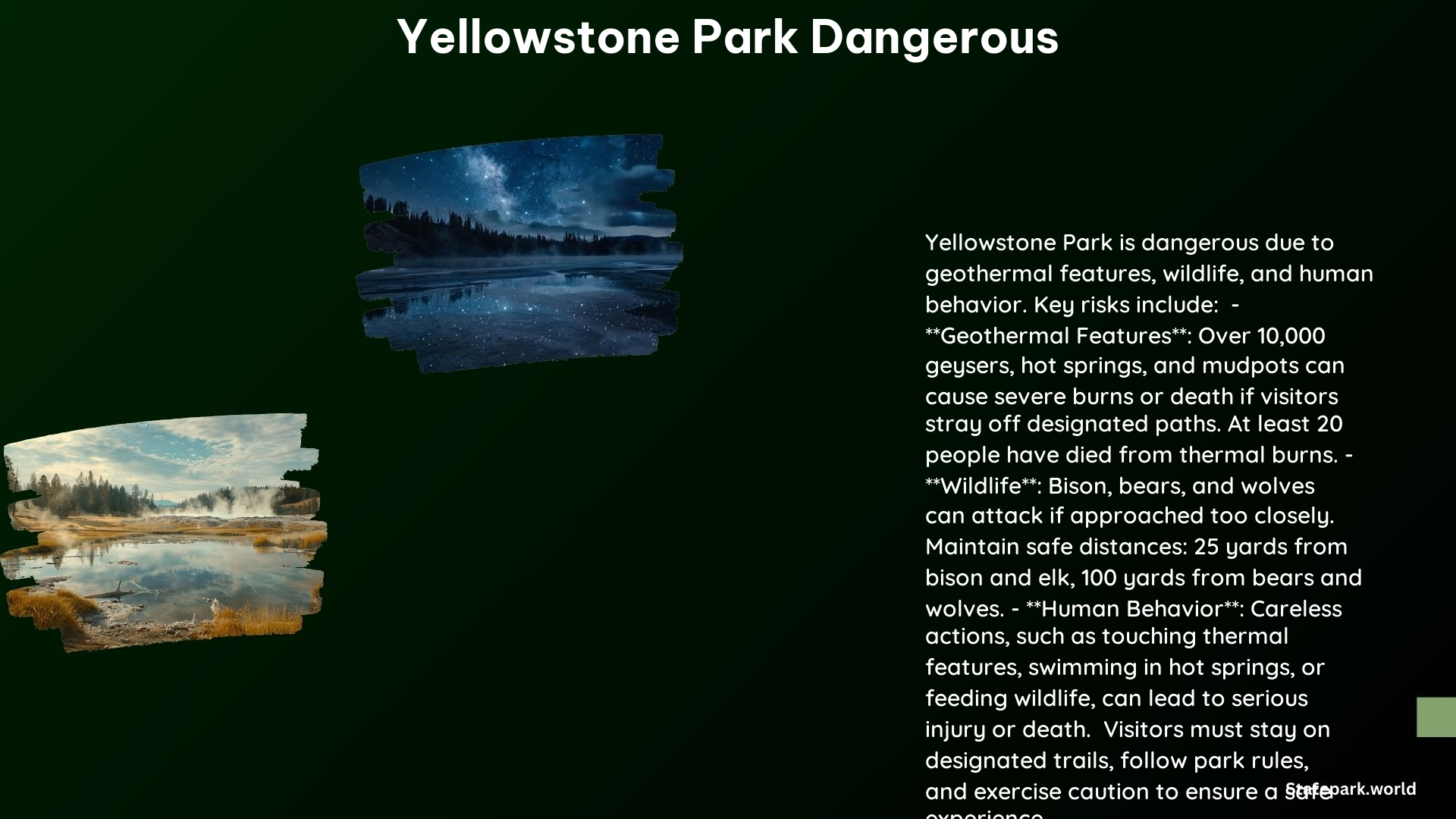Yellowstone National Park is a breathtaking natural wonder, but it also poses significant risks to visitors. From the scorching hot springs to the unpredictable wildlife, exploring this park requires a deep understanding of the dangers and a commitment to safety. In this comprehensive guide, we’ll delve into the critical details and advanced specifications you need to know to navigate Yellowstone’s hazards and enjoy your visit safely.
Geothermal Features: Extreme Temperatures and Unstable Terrain
Yellowstone’s geothermal features are both awe-inspiring and perilous. The park is home to a vast network of hot springs, geysers, and fumaroles, each with its own set of dangers.
Temperature Risks
The water in Yellowstone’s thermal features can reach temperatures of up to 250°F (121°C), which can cause severe burns and even death. Visitors who venture too close or attempt to touch or enter these features risk catastrophic injuries.
Crust Instability
The thin, breakable crust around hot springs and geysers can collapse without warning, leading to serious injuries or fatalities. Straying off designated trails and boardwalks significantly increases the risk of falling through the fragile ground.
Microbial Balance
Interfering with Yellowstone’s thermal features can disrupt the delicate balance of microorganisms that thrive in these unique environments. This can have far-reaching consequences for the park’s ecosystem, so it’s crucial to respect the boundaries and avoid tampering with these sensitive areas.
Wildlife Encounters: Maintaining a Safe Distance

Yellowstone is home to a diverse array of wildlife, including bison, elk, bears, and wolves. Encountering these animals can be both thrilling and dangerous, so it’s essential to follow proper protocols.
Distance Safety
Maintain a safe distance from wildlife at all times: at least 25 yards (23 meters) from bison, elk, and other animals, and at least 100 yards (91 meters) from bears and wolves. Approaching or getting too close to these animals can provoke aggressive behavior and lead to serious injuries or even fatalities.
Animal Behavior
Be aware of the potential for aggressive behavior in animals, especially bison mothers protecting their young. Sudden movements or getting between a mother and her calf can trigger a defensive response, putting visitors at risk.
Other Hazards: Drowning, Falling, and Supervolcano Risks
Yellowstone’s natural beauty can also conceal other dangers that visitors must be aware of.
Drowning and Falling
The park’s numerous water bodies and steep terrain pose risks of drowning and falling accidents. Visitors should exercise caution near these areas and avoid straying from designated trails and boardwalks.
Supervolcano Risks
Yellowstone sits atop a supervolcano, which, although unlikely to erupt in the near future, poses a long-term threat to the region. While the chances of a catastrophic eruption are low, it’s important for visitors to be aware of this potential hazard.
Safety Precautions: Protecting Yourself and the Park
To ensure a safe and enjoyable visit to Yellowstone, it’s crucial to follow these essential safety precautions:
- Stay on Designated Trails and Boardwalks: Avoid straying off the marked paths to prevent accidents and protect the delicate ecosystem.
- Respect Wildlife: Maintain a safe distance from all animals and never attempt to touch or feed them.
- Avoid Swimming or Soaking in Thermal Features: Never enter hot springs, geysers, or any other thermal features, as the water can cause severe burns.
- Supervise Children: Keep a close eye on children, especially near thermal features and wildlife, to prevent accidents.
Incidents and Statistics
Yellowstone’s dangers are not just theoretical – they have resulted in numerous incidents and fatalities over the years:
- Fatalities: Over 20 people have died from burns suffered after entering or falling into Yellowstone’s hot springs.
- Injuries: Many visitors have been severely burned or injured by the park’s thermal features.
- Wildlife Incidents: There have been numerous incidents of bison charging and goring visitors who got too close.
By understanding the risks and taking the necessary precautions, you can safely explore the wonders of Yellowstone National Park and create lasting memories of your adventure.
References
- https://www.yellowstonepark.com/park/faqs/dont-do-this-in-yellowstone/
- https://www.yellowstone.org/safety-and-hot-springs/
- https://www.usgs.gov/observatories/yvo/news/yellowstones-gravest-threat-visitors-its-not-what-you-might-think
- https://www.yellowstonepark.com/things-to-do/geysers-hot-springs/cautionary-tale/
- https://www.crazycanyonjournal.com/never-visit-yellowstone-national-park/
